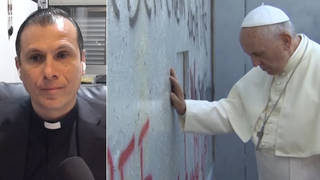
Guests
- Oscar Chacónexecutive director of Alianza Americas, an immigrant rights group based in Chicago. His recent essay for Medium is headlined “Why 'Abolish ICE' Doesn’t Go Far Enough for Migrant Families.”
We turn now to a leading Central American activist’s response to the crisis prompting thousands in Honduras, El Salvador and Guatemala to seek asylum in the United States. This week, the Trump administration announced it may have deported up to 463 parents of children separated by immigration officials at the border, even as their children remain in U.S. custody. This comes as a federal judge has ordered the Trump administration to reunite all separated migrant children and parents by Thursday, July 26.
Transcript
JUAN GONZÁLEZ: We end today’s show with a leading Central American activist’s response to the crisis prompting thousands in Honduras, El Salvador and Guatemala to seek asylum in the United States. This week, the Trump administration announced it may have deported up to—or, actually, disclosed it may have deported up to 463 parents of children separated by immigration officials at the border, even as their children remain in U.S. custody. This comes as a federal judge has ordered the Trump administration to reunite all separated migrant children and parents by Thursday, July 26th. But the administration says just over 1,000 parents have been reunited with their children so far—less than half of the families it must reunite by tomorrow. Earlier this month, President Trump pushed back against the court ruling mandating the reunification of families.
PRESIDENT DONALD TRUMP: Well, I have a solution: Tell people not to come to our country illegally. That’s the solution. Don’t come to our country illegally. Come like other people do. Come legally.
AMY GOODMAN: This comes as a federal judge in Boston ruled Monday a lawsuit can proceed in court that argues the Trump administration’s end to temporary protected status for immigrants in the United States from Honduras, Haiti, El Salvador was racially motivated. About 400,000 immigrants stand to lose their TPS, their temporary protected status, including more than 260,000 from El Salvador, nearly 60,000 people from Haiti and 86,000 from Honduras.
For more, we go to Chicago, where we’re joined by Oscar Chacón, executive director of Alianza Americas, the Alliance of the Americas, a network of Latin American immigrant-led organizations committed to advancing a public policy agenda to improving life in their communities in the U.S. and their countries of origin. His most recent essay for Medium is headlined “Why 'Abolish ICE' Doesn’t Go Far Enough for Migrant Families.”
So, here we are. It’s Wednesday, Oscar. Tomorrow is the deadline imposed by a federal judge in San Diego. The federal government is saying that they’ve reunited a thousand families. That’s not even half of the kids that they ripped away from their parents at the border. The deadline is tomorrow. Can you talk about the effect of this, how you’re organizing?
OSCAR CHACÓN: Absolutely. I mean, I think that the explanation to the fact that so few parents have actually been reunited with their kids is because the administration felt so incredibly confident that nobody was going to challenge these particular actions, and that they will never have to face, you know, the challenge of actually reuniting parents and children.
What we are essentially saying is, this particular episode that we’ve seen unfolding over the past several weeks is actually perhaps a preview of what we are likely to see over the next year or so, simply because as the termination of temporary protected status, DACA and other forms of remedies, that are often protecting people like the Central American immigrant community, come to an end, there will be far, far more children potentially separated from their kids. Take into account that just in terms of TPS recipients, there are nearly a quarter of a million U.S.-born children whose parents are only TPS recipients. And if they were to be, first, taken away of this particular protection, and then placed in potential deportation proceedings, put perhaps in detention and eventually deported, we may see a far larger challenge in as far as the images that we saw in the U.S. southern border recently.
So, clearly, to us, this is a situation where we need to go much deeper than we’ve gone so far. We believe it is important for Americans to understand that what’s been happening in the border has been happening for years and will likely happen even more so in the future. So we need to absolutely ramp up the efforts to ensure that people understand that this is a tragedy that has been long in the making and that has its foundations in laws that were actually passed long ago—1996, to be more precise. And unless we manage to gradually change these particular laws, we will continue to see these heartbreaking images of families being broken apart.
JUAN GONZÁLEZ: Well, Oscar, I wanted to ask you that, about the roots of this problem, because we’ve been hearing a lot lately, and certainly in the progressive community, about the call to abolish ICE.
OSCAR CHACÓN: I’m not listening anything.
JUAN GONZÁLEZ: But most people, most Americans do not realize that ICE was only created in 1996 as a result of the law you mentioned, the Immigration and Reform Act of 1996, that was signed into law by President Clinton. I’m wondering if you could talk about how that law really set the stage for what happened not only under President Obama, but especially now, under President Trump. I think we’re having a little problem with Oscar hearing us. Can you hear us, Oscar?
OSCAR CHACÓN: Yes, I believe I can hear you now. For a minute, I was out, without audio from you guys. Sorry.
JUAN GONZÁLEZ: OK. Well, let me repeat that. There’s been a lot of calls recently for the abolition of ICE. But most Americans are not aware that ICE is a relatively new agency in government affairs. It came out of the 1996 act that you alluded to, the Immigration and Reform Act. I’m wondering if you could talk more about how that act, signed by President Clinton, set the stage for these mass deportations that occurred both under President Obama and now, especially, ramped up under President Trump. What was it about that law that made what’s happening now possible?
OSCAR CHACÓN: Well, let me begin by saying that the 1996 immigration act was actually the evolution of a movement that actually originated much earlier and that first came into national awareness in 1994 in the context of a gubernatorial race in California. You may recall that California voters actually adopted Proposition 187, which was a very rudimentary anti-immigrant ballot initiative in California, and it passed. Many people thought that the fact that the Supreme Court stopped most of Proposition 187 from ever going into effect was the end of the story, but, in reality, it was only the launching moment for what became federal policy in 1996.
At the heart of the 1996 immigration policy reform was a belief that painted all immigrants, but particularly Mexican and Latin American immigrants, as some sort of threat to the country. That particular threat was again enshrined, essentially, into this particular immigration law, that is driven by three critical principles: exclusion, restriction and punishment. And what they really wanted to do with this particular act was to stop people that many racist, white supremacist forces considered to be undesirable as residents of the U.S., but also wanted to kick out of the country as many people as possible also deemed as undesirable. So, what we have had in the books since 1996 has been a horrible piece of law that actually makes possible everything that we have seen from that point forward. The events of 9/11 in 2001 only bolstered even more this basic architecture of foreigners and immigrants as threats to the country.
And as you pointed out, ICE is a relatively new agency. The problem is not necessarily an enforcement agency, because when you have good laws in place, it is important to indeed enforce the laws. The problem we have, essentially, is that whether it is ICE or whether it is the Border Patrol, the bottom line is, the law that they are charged with enforcing is a horrible piece of legislation, that, frankly, unless we manage to gradually chip it away, destroy it, abolish it, we will continue to face the same horrifying images that we have seen at the border and that we see on a daily basis whenever ICE carries out raids against people who are hard-working, tax-paying contributors to the United States of America.
AMY GOODMAN: Can you talk about the sanctuary movement today around the country, where particularly women, Central American women, are taking refuge in churches, communities protecting them, and how it compares to what happened in the 1980s, the sanctuary movement here in the United States, with the U.S. backing of the right-wing regimes, the terribly murderous regimes, in Guatemala, in Honduras, in El Salvador?
OSCAR CHACÓN: Well, first of all, let me say that as someone who came to the U.S. still in my teenage years in 1980 and who became involved in what was broadly known as the solidarity movement back in the 1980s, I actually had a very close relationship with the sanctuary movement back then. I believe it was a practical statement of disagreement by people of faith in this country to policies that were being enacted by the federal government, precisely against Central American immigrants running away mostly from dictatorial, right-wing regimes in Central America.
What I see today—indeed, there is a so-called new sanctuary movement—is a gradual expression again of dissenting voices, mainly from faith communities, that are appalled at the policies that we continue to have in place, that we continue to enforce. And I believe that sanctuary movement, whether it is in the form of places of worship or actually cities declaring themselves sanctuary, are once again expressions, very important expressions, of a dissenting voice that is trying to once again point out that these actions are far from what most Americans would consider morally acceptable. And I believe they will play a very important role in gradually reversing the policies, and the actions that follow the policies, that make so many people ashamed of our government and ashamed of the actions that have been taking place more recently at the U.S. southern border. But, I emphasize, these actions take place in many cities throughout the country because of enforcement agencies like ICE implementing a horrible law like the one we passed in 1996.
JUAN GONZÁLEZ: And finally, we only have about 45 seconds, but if you could comment on how the change of government in Mexico may have an impact, from your perspective, on the continuing crisis at the border between the U.S. and Mexico?
OSCAR CHACÓN: Well, I mean, we are hopeful that the new administration will actually take a deep look at the policies that have been in effect over the past several years. I like to point out that following the so-called humanitarian crisis declared by President Obama in 2014, the Mexican government, for all practical purposes, became the extended border for the U.S. And we’ve seen a huge increase in the deportations from Mexico, essentially replicating the deportation practices that the U.S. had been engaged in.
So we are hopeful that the new administration will again take a fresh look at this and reassess whether this is the right policy for Mexico, a nation that prides itself from saying that it is an international human rights leader. We just don’t see that in practice, but we’d love to see that come to be the case with the new administration.
AMY GOODMAN: Oscar Chacón, we want to thank you for being with us, executive director of Alianza Americas. His recent essay, we’ll link to, at Medium, “Why 'Abolish ICE' Doesn’t Go Far Enough for Migrant Families.”
That does it for our show. Democracy Now! has a job opening for a broadcast engineer here in New York City. Find out more at democracynow.org.












Media Options